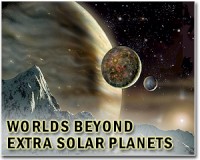 |
Pasadena CA (JPL) Jun 24, 2010 Many scientists speculate that our galaxy could be full of places like Pandora from the movie "Avatar" - Earth-like worlds in solar systems besides our own. That doesn't mean such worlds have been easy to find, however. Of the 400-plus planets so far discovered, none could support life as we know it on Earth. "The problem with finding Earth-like planets," said Stefan Martin, an engineer at NASA's Jet Propulsion Laboratory, Pasadena, Calif., "is that their host stars can emit 10 million times more infrared light than the planet itself. And because planets like ours are small and orbit very close to their respective stars, it makes Earths almost impossible to see." Together with A.J. Booth (formerly at JPL and now at Sigma Space Corp., Lanham, Md.), Martin may have developed a way to make this almost impossible feat a reality. Their instrument design, called a "nulling interferometer," observes planets in infrared light, where they are easier to detect. It is designed to combine starlight captured by four different telescopes, arranging the light waves from the star in such a way that they cancel each other out. "We're able to make the star look dimmer - basically turning it off," Martin said. Nulling interferometry is not a new idea, but what sets the results from Martin and Booth apart is how effective it turned out to be. "Our null depth is 10 to 100 times better than previously achieved by other systems," Martin said. "This is the first time someone has cross-combined four telescopes, set up in pairs, and achieved such deep nulls. It's extreme starlight suppression." That suppression could allow scientists to get a better look at exoplanets than ever before. "We're able to make the planet flash on and off so that we can detect it," Martin said. "And because this system makes the light from the star appear 100 million times fainter, we would be able to see the planet we're looking for quite clearly."
Pandora, up close and personal Another method of observing exoplanets is coronagraphy, which uses a mask to block the optical light of a star, making its surrounding planets more easily visible. And the proposed SIM Lite mission would also be able to find nearby planets by observing the gravity-induced "wobbling" of their host stars. However, Martin and Booth's nulling interferometer could eventually give astronomers the ability to get up close and personal with Earth-like worlds, analyzing their atmospheres for signs of habitability or even possibly life. "We expect to eventually be able to see hundreds of planets with this technique," Martin said. The technology that they've developed could be used on a follow-up space mission to SIM Lite and Kepler. Martin is now planning to test the system in conditions that better mimic a real-life mission. Once considered the stuff of science fiction, it may not be long before Earth-like planets, or, in the case of Pandora, Earth-like moons of giant planets, are found to exist other places besides the silver screen.
Share This Article With Planet Earth
Related Links Jet Propulsion Laboratory Lands Beyond Beyond - extra solar planets - news and science Life Beyond Earth
 Astronomers glimpse distant planet's lethal moods
Astronomers glimpse distant planet's lethal moodsParis (AFP) June 23, 2010 A planet named after ancient Egypt's Lord of the Dead is a place where human beings would be simultaneously boiled, poisoned and ripped apart by superstorms, astronomers reported on Wednesday. The distant world, orbiting a bright star in the constellation of Pegasus 150 light years from Earth, is known officially as HD 209458b, but has been nicknamed Osiris, the god of the Egyptian underworl ... read more |
|
| The content herein, unless otherwise known to be public domain, are Copyright 1995-2010 - SpaceDaily. AFP and UPI Wire Stories are copyright Agence France-Presse and United Press International. ESA Portal Reports are copyright European Space Agency. All NASA sourced material is public domain. Additional copyrights may apply in whole or part to other bona fide parties. Advertising does not imply endorsement,agreement or approval of any opinions, statements or information provided by SpaceDaily on any Web page published or hosted by SpaceDaily. Privacy Statement |